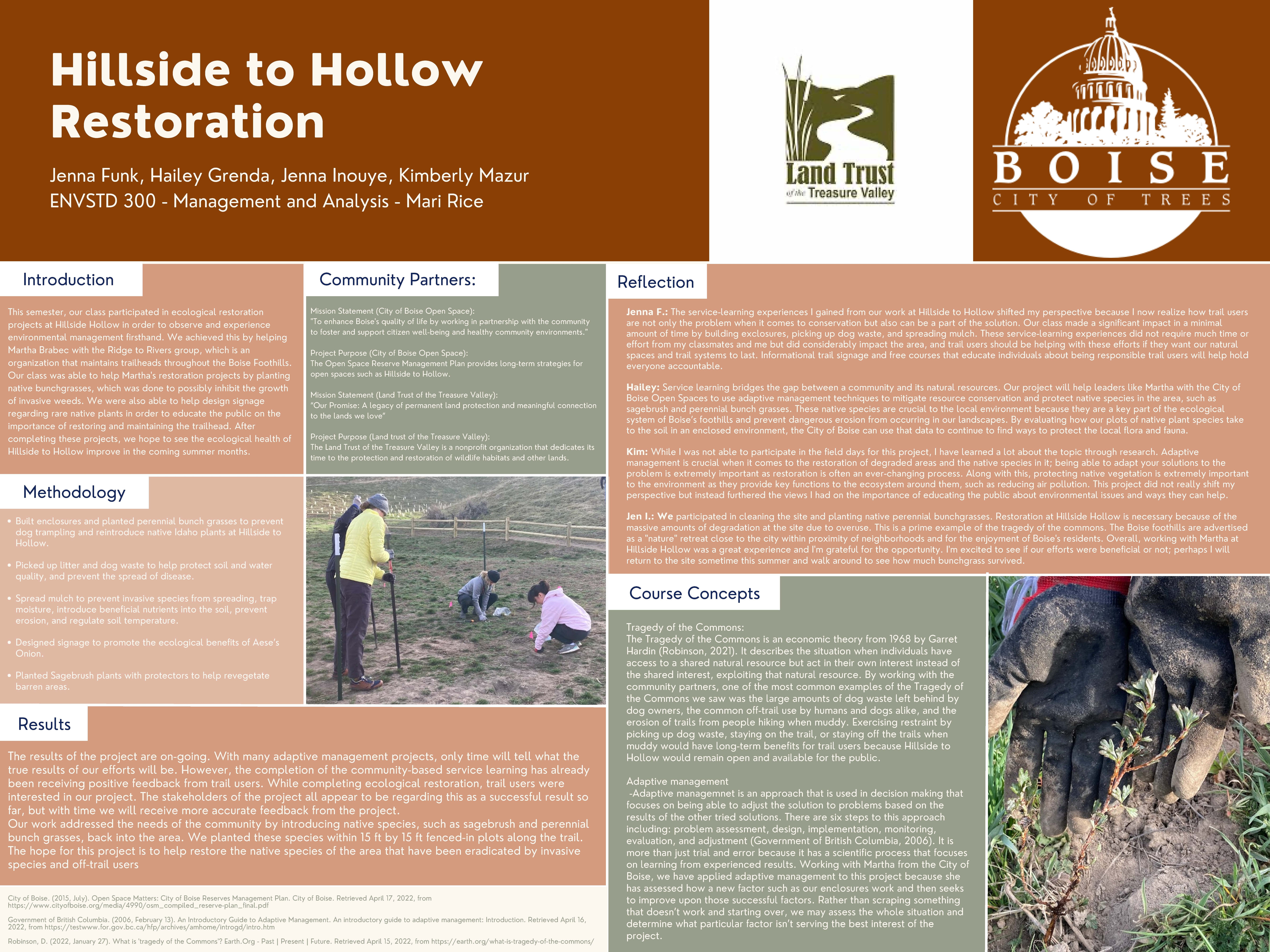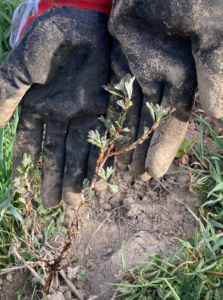Jenna Funk, Hailey Grenda, Jenna Inouye, & Kimberly Mazur
Dr. Mari Rice (Ed. D) – ENVSTD 300
Land Trust of the Treasure Valley & City of Boise – Open Spaces

Introduction
This semester, our class participated in ecological, restoration projects at Hillside Hollow in order to observe and experience environmental management firsthand. We achieved this by helping Martha Brabec with the Ridge to Rivers group, which is an organization that maintains trailheads throughout the Boise Foothills. Our class was able to help Martha’s restoration projects by planting native bunch grasses, which was done to possibly inhibit the growth of invasive weeds. We were also able to help design signage regarding rare native plants in order to educate the public on the importance of restoring and maintaining the trailhead. After completing these projects, we hope to see the ecological health of Hillside to Hollow improve in the coming summer months.
Reflection
Jenna F.: The service-learning experiences I gained from our work at Hillside to Hollow shifted my persepctive because I now realize how trail users are not only the problem when it comes to conservation but also can be a part of the solution. Our class made a significant impact in a minimal amount of time by building exclosures, picking up dog waste, and spreading mulch. These service-learning experiences did not require much time or effort from my classmates and me but did considerably impact the area, and trail users should be helping with these efforts if they want our natural spaces and trail systems to last. Informational trail signage and free courses and educate individuals about being responsible trail users will help hold everyone accountable.
Hailey: Service learning bridges the gap between a community and its natural resources. Our project will help leaders like Martha with the City of Boise Open Spaces to use adaptive management techniques to mitigate resource conservation and protect native species in the area, such as sagebrush and perennial bunch grasses. These native species are crucial to the local environment because they are a key part of the ecological system of Boise’s foothills and prevent dangerous erosion from occurring in our landscapes. By evaluating how our plots of native plant species take to the soil in an enclosed environment, the City of Boise can use that data to continue to find ways to protect the local flora and fauna.
Kim: While I was not able to participate in the field days for this project, I have learned a lot about the topic through research. Adaptive management is crucial when it comes to the restoration of degraded areas and the native species in it; being able to adapt your solutions to the problem is extremely important as restoration is often an ever-changing process. Along with this, protecting native vegetation is extremely important to the environment as they provide key functions to the ecosystem around them, such as reducing air pollution. This project did not really shift my perspective but instead furthered the views I had on the importance of educating the public about environmental issues and ways they can help.
Jen I.: We participated in cleaning the site and planting native perennial bunch grasses. Restoration at Hillside Hollow is necessary because of the massive amounts of degradation at the site due to overuse. This is a prime example of the tragedy of the commons. The Boise foothills are advertised as a “nature” retreat close to the city within proximity of the neighborhoods and for the enjoyment of Boise’s residents. Overall, working with Martha at Hillside Hollow was a great experience and I’m grateful for the opportunity. I’m excited to see if our efforts were beneficial or not; perhaps I will return to the site sometime this summer and walk around to see how much bunch grass survived.
Community Partners: Land Trust of the Treasure Valley & City of Boise – Open Spaces
Mission Statement:
“To enhance Boise’s quality of life by working in partnership with the community to foster and support citizen well-being and health community environments.” (City of Boise Open Space)
“Our Promise: A legacy of permanent land protection and meaningful connection to the lands we love.” (Land Trust of the Treasure Valley)
Project Purpose:
The Open Space Reserve Management Plan provides long-term strategies for open spaces such as hillside to Hollow. (City of Boise Open Space)
The Land Trust of the Treasure Valley is a nonprofit organization that dedicates its time to the protection and restoration of wildlife habitats and other lands. (Land Trust of the Treasure Valley)

Course Concepts
Tragedy of the Commons:
The Tragedy of the Commons is an economic theory from 1968 by Garret Hardin (Robinson, 2021). It describes the situation when individuals have access to a shared natural resource but act in their own interest instead of the shared interest, exploiting that natural resource. By working with the community partners, one of the most common examples of the Tragedy of the Commons we saw was the large amounts of dog waste left behind by dog owners, the common off-trail use by humans and dogs alike, and the erosion of trails from people hiking when muddy. Exercising restraint by picking up dog waste, staying on the trail, or staying off the trails when muddy would have long-term benefits for trail users because Hillside to Hollow would remain open and available for the public.
Adaptive management:
Adaptive management is an approach that is used in decision making that focusses on being able to adjust the solution to problems based on the results of the other tried solutions. There are six steps to this approach including: problem assessment, design, implementation, monitoring, evaluation, and adjustment (Government of British Columbia, 2006). It is more than just trail and error because it has a scientific process that focuses on learning from experienced results. Working with Martha from the City of Boise, we have applied adaptive management to this project because she has assessed how a new factor such as our enclosures work and then seeks to improve upon those successful factors. Rather than scraping something that doesn’t work and starting over, we may assess the whole situation and determine what particular factor isn’t serving the best interest of the project.
Methodology
- Built enclosures and planted perennial bunch grasses to prevent dog trampling and reintroduce native Idaho plans at Hillside to Hollow.
- Picked up litter and dog waste to help protect soil and water quality, and prevent the spread of disease.
- Spread mulch to prevent invasive species from spreading, trap moisture, introduce beneficial nutrients into the soil, prevent erosion, and regulate soil temperature.
- Designed signage to promote the ecological benefits of Aese’s Onion.
- Planted Sagebrush plants with protectors to help revegetate barren areas.

Results
The results of the project are on-going. With many adaptive management projects, only time will tell what the true results of our efforts will be. However, the completion of the community-based service learning has already been receiving positive feedback from trail users. While completing ecological restoration, trail users were interested in our project. The stakeholders of the project all appear to be regarding this as a successful result so far, but with time we will receive more accurate feedback from the project.
Our work addressed the needs of the community by introducing native species, such as sagebrush and perennial bunch grasses, back into the area. We planted these species within 15 ft by 15 ft fenced-in plots along the trail. The hope for this project is to help restore the native species of the area that have been eradicated by invasive species and off-trail users.